Tomatoes are a beloved addition to any backyard garden, thanks to their ease of cultivation and the unbeatable flavor of homegrown fruits. But, what are the best tomatoes to grow in Southern California?
Luckily, there’s a plethora of tomato varieties that thrive in Southern California’s warm summer months, especially when you adhere to our tried-and-true tomato cultivation tips. Some types are more prolific than others, and certain varieties have been specifically bred to excel in this region’s unique climate.
Here’s our selection of the finest tomatoes to cultivate in Southern California, ranging from delightful bite-sized treats to stunning heirloom varieties that’ll be showstoppers in your summer salads.
Top Tomato Varieties for Southern California
Paul Robeson Tomato

The Paul Robeson tomato is potentially my top choice for a slicing tomato in Southern California gardens. This stunning beefsteak boasts an eye-catching appearance and classic heirloom charm, but it offers so much more than just good looks.
This variety is a breeze to cultivate, with fruits ripening in just 65-70 days, and it’s known for its high yield. Plus, it might just be one of the most delicious tomatoes – if not THE most delicious – you’ll ever taste.
Named in honor of Paul Robeson, a renowned actor, opera singer, athlete, and civil rights activist, these tomatoes typically measure 3-4 inches in size. They thrive in temperatures below 95 degrees, so they’re well-suited to hot inland regions as well as milder coastal areas of Southern California. Make sure to stake or trellis these long-vining tomatoes for the best results.
You’ll often find this heirloom variety among the tomato seedlings at local nurseries, and even well-stocked home improvement stores are beginning to carry them. Alternatively, you can purchase seeds for this tomato variety online.
Brandywine Tomato

Another fantastic beefsteak tomato perfect for slicing is the Brandywine. This tomato plant features large leaves and yields sizable fruit in an array of colors, with pink and red being the most common.
This popular tomato plant has a distinct, old-fashioned charm, and its larger leaves set it apart from other plants in your garden.
The Brandywine is a later-ripening variety, with harvesting typically commencing around the 90-day mark. As an indeterminate plant, it thrives in high temperatures, as long as it receives ample water and tomato food.
Once mature, these tomatoes can weigh nearly a pound! Due to their slow ripening process, they can be more susceptible to pests. To deter unwelcome visitors, I like to plant marigolds and onions alongside my tomatoes. Watering from below also helps keep the plant in tip-top shape.
You’ll find Brandywine plants at most plant nurseries and home improvement store garden centers throughout Southern California.
Momotaro Tomato
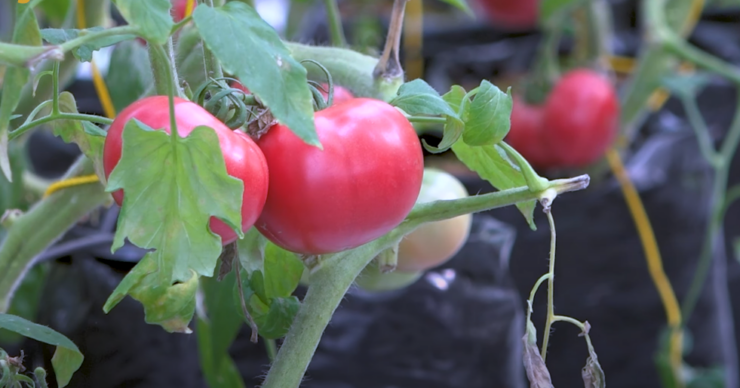
The Momotaro Tomato, a favorite variety in Japan, has gained popularity at farmers’ markets thanks to its beautiful pink flesh, sweet taste, and impressive shelf life. This tomato truly has a classic appearance.
The name “Momotaro” comes from the legendary Peach Boy, a baby boy discovered inside a giant peach by farmers longing for a child. As he grew, Momotaro became a celebrated figure promoting peace, and now Japan holds an annual Momotaro Festival in his honor.
I can’t help but wonder if Roald Dahl’s classic children’s book, James and the Giant Peach, was inspired by this tale…
Momotaro Tomatoes are early producers, reaching maturity in just 60 days, and each fruit weighs about half a pound. As an indeterminate plant, it will continue to produce throughout the season, with each cluster of flowers yielding 6-7 fruits.
It isn’t a fan of extreme heat, so temperatures consistently above 95 degrees may cause flowers to drop. If you live in an area with such temperatures, simply plant early and treat it as an early-season variety.
Green Zebra Tomato
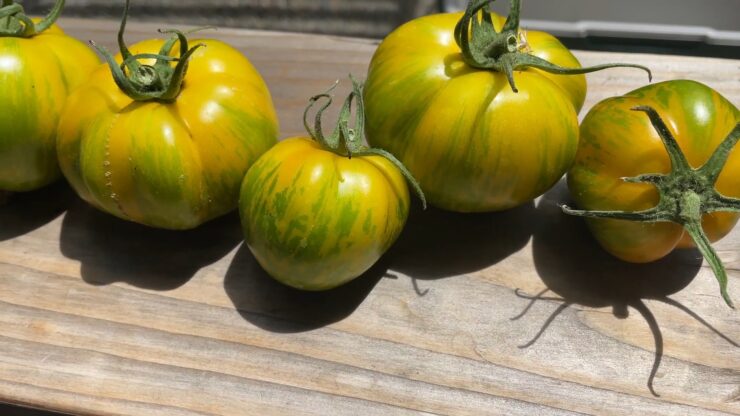
Every heirloom garden deserves a touch of excitement, and the Green Zebra Tomato delivers just that. This eye-catching green, striped tomato features hints of yellow when ripe, adding a vibrant twist to your garden.
These tomatoes are about two inches in diameter and reach maturity in around 75 days. Their flavor is delightful—sweet with a tangy kick. Year after year, I find these tomatoes easy to grow, although the plants tend to stay around 4-5 feet tall, slightly smaller than some other varieties.
Green Zebra gained popularity when Alice Waters featured them in her heirloom tomato dishes at Chez Panisse. Today, they’re the most widely available green heirloom tomato, known for their fantastic taste and ease of cultivation.
Since they’re green tomatoes, determining ripeness relies on touch—when they feel soft, they’re ready to enjoy.
You can find Green Zebra plants at Home Depot, Green Thumb, Rogers Gardens, and virtually any garden center with a diverse selection of tomato seedlings.
Cherokee Purple Tomato
The Cherokee Purple Tomato is a beloved heirloom variety, perfect for slicing with its 8-12oz size when fully ripe. This stunning boasts a unique, dusky purple and pink hue with hints of red, and some even exhibit greenish areas at the top when ripe.
Renowned for its gorgeous appearance, sweet and smoky flavor, and ease of cultivation, this tomato is believed to have originated with the Cherokee tribe and has been grown for over a century.
What sets the Cherokee Purple apart is its exceptional disease resistance, making it a breeze to grow. It reaches maturity in about 80-90 days, with plants yielding 20-25 tomatoes per season. As an indeterminate, it will continue producing throughout the growing season.
Gold Medal Tomato
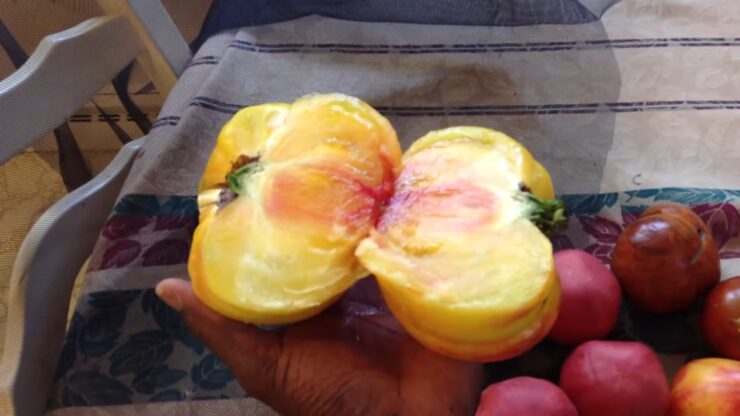
For those who crave a tomato that boasts both captivating color and irresistible flavor, the Gold Medal Tomato (also known as Ruby Gold) is your perfect pick.
Featuring striking tropical hues of yellow and pinkish-red streaks, this tomato also delights the taste buds with its sweet and slightly tropical flavor profile.
This century-old beefsteak variety is a must-have addition to any garden, thriving in both smart pots and raised beds. Prepare to be amazed by the Gold Medal’s incredible productivity, as it yields dozens of tomatoes from just one plant! The large, 16 to 18oz fruits start ripening around 75-85 days and can stay fresh for a couple of weeks if you can resist indulging for that long.
Best Small Tomatoes to Grow in Southern California
Sweet 100 Cherry: The Perfect Patio Plant

For a simple-to-grow tomato that thrives in pots or garden beds, look no further than the Sweet 100 Cherry Tomato. These prolific plants produce delightful cherry tomatoes that are perfect for salads or snacking straight off the vine.
Reaching maturity in just 65 days, these indeterminate plants will have you enjoying cherry tomatoes all summer long. Their close relative, the Super Sweet 100, is also an excellent choice, and both varieties are easily found in Southern California at home improvement stores and nurseries.
Ideal for those with limited space, Sweet 100s flourish in pots, making them great for patio gardening. Just remember to stake or cage the plant, as it can grow over 4 feet tall with proper care.
Sungold Cherry: A Flavorful Burst of Sunshine
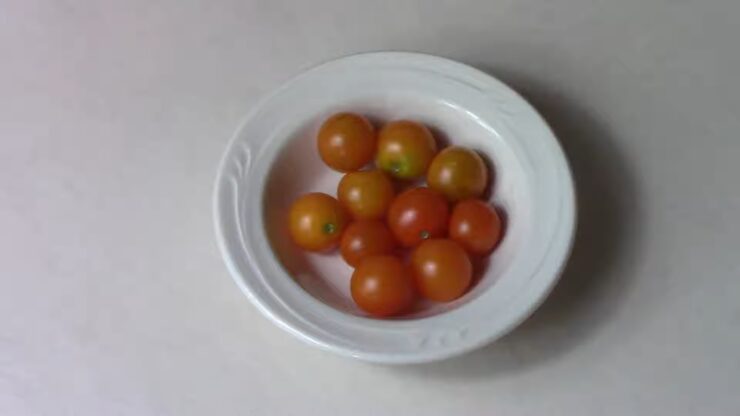
With its incredible flavor, the Sungold Cherry Tomato might just be your new favorite. These orange gems ripen in 60 days and are perfect for salads, pasta dishes, or simply snacking. You might even catch your little ones enjoying these tasty treats straight from the vine.
As an indeterminate, Sungold keeps producing from the beginning to the end of the growing season. Plant them in the ground, raised beds, or pots, and they’ll stay healthy and content with ample sunshine, food, and water.
Yellow Pear Tomato: Add a Splash of Color to Your Dishes

For a pop of color and vibrancy in your summer salads, the Yellow Pear Tomato is a must. These small, pear-shaped tomatoes are abundant once the plant matures at 78 days.
This indeterminate heirloom variety can have vines reaching up to eight feet long, so make sure to stake them. Widely used in preserves, these charming 1-2″ tomatoes are also quite disease resistant – just watch out for pests like aphids and worms.
Best Tomatoes for Canning and Sauces in Southern California: Roma and San Marzano
Roma Tomatoes are a popular choice for canning and sauces, but nothing beats the taste of a homegrown Roma. With very few seeds, they’re perfect for sauces and canning. As a determinate variety, they produce most of their fruit all at once, making them great for big batches of sauce to freeze or can. Maturing in 70 days, Roma can be grown in raised beds or large containers.
San Marzano Tomatoes, often used in high-quality canned tomatoes, make the most delicious sauces. These larger, indeterminate they have thick flesh and few seeds, making them ideal for rich sauces. They mature at 85 days, providing a bountiful harvest throughout the season. Plant both Roma and San Marzano Tomatoes for a continuous supply of sauce-worthy fruits.
FAQs
What are the best varieties for Southern California?
Southern California has a diverse climate, so there are many varieties of tomatoes that can thrive here. Some of the best varieties include Paul Robeson, Brandywine, Momotaro, Green Zebra, Cherokee Purple, Gold Medal, Sweet 100 Cherry, Sungold Cherry, Yellow Pear, Roma, and San Marzano.
How do I know when my tomatoes are ripe and ready to harvest?
Ripe tomatoes will have a deep, uniform color and will feel slightly soft when gently squeezed. The exact color and feel will vary depending on the specific variety. For example, Green Zebra tomatoes will have a mix of green and yellow shades, while Cherokee Purple tomatoes will have a dusky purple and pink hue.
What are the best varieties for container gardening?
Sweet 100 Cherry, Sungold Cherry, and Yellow Pear tomatoes are excellent choices for container gardening. They are compact, produce bountiful harvests, and can be grown in pots on patios or balconies.
How can I prevent pests and diseases from damaging my tomato plants?
Planting marigolds and onions near your tomato plants can help deter pests. Additionally, make sure to water your plants from below, as this helps keep the foliage dry and less susceptible to diseases. Regularly check your plants for signs of pests or disease and take action promptly if you notice any issues.
What type of support should I provide for my tomato plants?
Most tomato plants benefit from staking or trellising, which helps support their growth and keeps the fruit off the ground. Indeterminate varieties, in particular, need strong support, as they continue to grow and produce fruit throughout the season.
How often should I water and feed my tomato plants?
They generally require regular watering, especially during hot and dry periods. Ensure that the soil stays consistently moist, but not waterlogged. Feed your plants with a balanced tomato fertilizer according to the package instructions, typically every 4-6 weeks.
Can I grow different varieties of tomatoes in the same garden bed or container?
Yes, you can grow different varieties of tomatoes together, as long as they have similar growing requirements. Just make sure to provide enough space between the plants to allow for proper air circulation and growth.
Are there any heirloom tomatoes that are particularly disease-resistant?
Cherokee Purple tomatoes are known to be more disease-resistant than many other heirloom varieties, making them a great choice for gardeners looking for easy-to-grow heirloom tomatoes.
Bottom Line
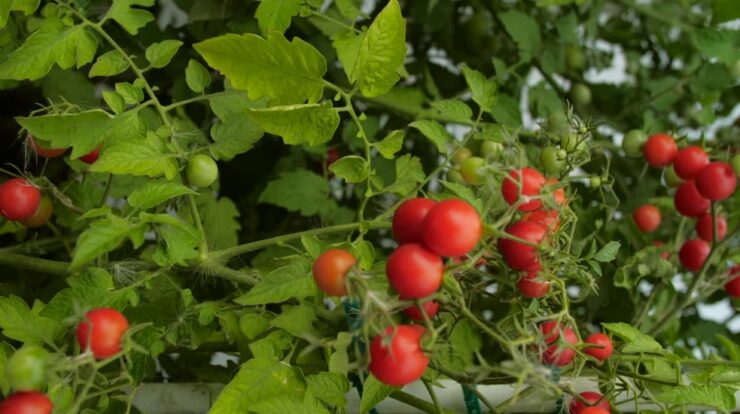
Growing tomatoes in Southern California can be a delightful and rewarding experience. With a wide variety of tomatoes to choose from, including heirlooms, hybrids, and cherry tomatoes, there’s something for every gardener’s taste and preference.
By selecting the right varieties for your specific climate and growing conditions, you can enjoy a bountiful harvest of delicious, homegrown tomatoes throughout the season.
Remember to provide your plants with proper support, water, and nutrients to ensure their success.
Don’t be afraid to experiment with different varieties, and most importantly, have fun cultivating your garden in Southern California’s unique and diverse climate.
Happy gardening!

